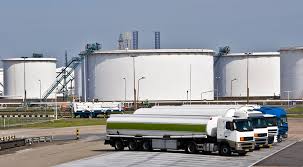Base Oil (SN 150) Importation, Storage and Distribution in Nigeria; The Feasibility Report.

Lubricating oil is a substance (often a liquid) introduced between two moving surfaces to reduce the friction between them, improving efficiency and reducing wear. They may also have the function of dissolving or transporting foreign particles and of distributing heat.
Lubricants today are classified into two major groups: Automotive lubricants and Industrial lubricants. One of the single largest applications for lubricants, in the form of motor oil is to protect the internal combustion engines in motor vehicles and powered equipment.
Practically lube oil contain about 90% base oil (most often petroleum fractions, called mineral oils) and 10% additives. Vegetable oils or synthetic liquids such as hydrogenated polyolefin, esters, silicones, fluorocarbons and many others are sometimes used as base oils. Additives deliver reduced friction and wear, increased viscosity, improved viscosity index, resistance to corrosion and oxidation, aging or contamination, etc.
The basic functions of a lubricant are friction and wear reduction, heat removal and contaminant suspension. Apart from important application in internal combustion engines, vehicles and industrial gear boxes, compressors, turbines or hydraulic systems, there are vast numbers of other applications, which mostly require specifically tailored lubricants.
Lubricating oil are guided by the following standards
A. The American Petroleum Institute (API). The API sets the Standard for formulation, classification of Lubes in the world and which also defines its production and apparatus used.
B. The Society of Automobile Engineers (SAE). The SAE is a U.S. based globally active professional association and standards organization for engineering professionals in various industries. Principal emphasis is placed on transport industries such as automotive, aerospace, and commercial vehicles. The Society coordinates the development of technical standards based on best practices identified and described by SAE committees and task forces on Engines and Oil classifications.
In Nigeria, the industry is regulated by the Department of Petroleum Resources {DPR} and Standard Organisation of Nigeria {SON}. While DPR licenses firms to produce any petroleum product, SON monitors quality of products to ensure standardisation
To ensure that lubricants produced conform to specification, the blending Plant would have a well-equipped laboratory for testing raw materials (base oils & additives), and blended lubricants.
Though the ability to minimize friction is the number one function of a lubricant, there are other major functions that must be considered. A lubricant is likely to also be required to:
Clean – A lubricant must maintain internal cleanliness by suspending contaminants or keeping contaminants from adhering to components.
Cool Moving Elements – Reducing friction will reduce the amount of heat that is generated and lower the operating temperature of the components. A lubricant must also absorb heat from the components and transport it to a location where it can be safely dissipated.
Prevent Contamination – The lubricant should act as a dynamic seal in locations such as the piston, piston ring and cylinder contact areas. This minimizes contamination by combustion byproducts (for example) in the lubricating system. Lubricants are also relied upon to support mechanical seals found elsewhere and to minimize external contamination and fluid loss.
Dampen Shock – The lubricant may be required to cushion the blows of mechanical shock. A lubricant film can absorb and disperse energy spikes over a broader contact area.
Transfer Energy – A lubricant may be required to act as an energy transfer median as in the case of hydraulic equipment or lifters in an automotive engine.
Prevent Corrosion – A lubricant must also have the ability to prevent or minimize internal component corrosion. This can be accomplished either by chemically neutralizing the corrosive products or by setting up a barrier between the components and the corrosive material.
The Nigerian Lube industry is presently worth N 700 billion with growth predicted at 25% in the next 3 Years. This growth has induced many of the Lube producers in Nigeria to plan the Increase of their Blending capacity.
There are currently 32 licensed lube blenders in Nigeria with a total base stock capacity of 114 Million Litres.
This report examines the financial viability of importing five thousand (5,000) tons of base oil (SN 150) monthly, storing and marketing same in the local market.
Table of Contents
EXECUTIVE SUMMARY 1.0 Business Overview 1.1 Description of the Business 1.2 Vision and Mission Statement 1.3 Critical Success Factor of the Business 1.4 Current Status of Business 1.5 Description of the Business Industry 1.6 Contribution to Local and National Economy 2. Marketing Plan 2.1 Description of product 2.2 The Opportunity 2.3 Pricing Strategy 2.4 Target Market 2.5 Distribution and Delivery Strategy 2.6 Promotional Strategy 2.7 Competition 3. Product Plan 3.1 Description of the Location 3.2 Product Storage 3.3 Procurement and Import Process 3.4 Machinery and Equipment 3.5 Product Cost 3.6 Stock Control Process 3.7 Pre-Operating activities and expenses 3.7.1 Operating Activities and Expenses 3.8 Project Implementation Schedule 4.0 Organizational and Management Plan 4.1 Ownership of the business 4.2 Profile of the promoters 4.3 Key Management Staff 4.3.2 Management Support Units 4.4 Details of salary schedule 5. Financial Plan 5.1 Financial Assumption 5.2 Start – up Capital Estimation 5.3 Source of Capital 5.4 Security of Loan 5.5 Loan Repayment Plan 5.6. Profit and Loss Account 5.7 Cash Flow Analysis 5.8 Viability Analysis 6.0 Business Risk and mitigation factor 6.1 Business Risks 6.2 SWOT Analysis
Project Specification:
Additional Info
Get this Report
Direct bank transfer
To order the report, Please do pay the sum of ₦100,000 into
Account Name : Foraminifera Market Research Ltd
Account Number : 274 20 569 37
Account Name : Foraminifera Market Research Ltd
Account Number : 101 76 603 95
Account Name : Foraminifera Ventures
Account Number : 011 66 066 32
Make your payment directly into our bank account. Please use your Order ID as the payment reference. Your order will not be shipped until the funds have cleared in our account.
Instructions
After payment call us on 01 -29 52 413 / 08033782777 or email us at foraminiferamarketresearch@yahoo.com with the payment details. After payment confirmation, the soft copy of the report would be sent to you within 24 hours.


